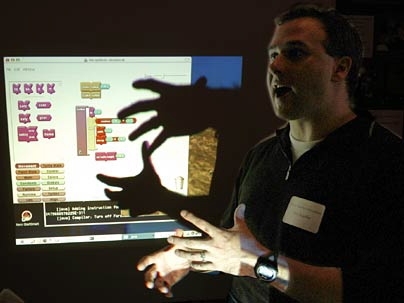Faculty, students and educational technology professionals attended an Educational Technology Fair at MIT on Nov. 2 to see examples of technology currently being utilized in classrooms, libraries and other areas of MIT and to find out how to incorporate them into their own work.
All of the projects that were exhibited in Lobby 13 are currently being used at MIT and are ready for consideration by other faculty for their classrooms.
"One of the main goals of the Ed Tech Fair is to give the MIT community a better perspective on the breadth and depth of educational technology research being done here, and also to display the passionate interest of some of our faculty for finding ways to improve teaching through the thoughtful use of technology," said Jean Foster, team leader in Academic Computing and one of the fair's organizers.
"The turnout demonstrated the myriad ways in which computer technology is being used to expand teaching and learning across the campus," said Jerry Grochow, vice president, Information Services and Technology at MIT. "The fact that faculty came to show off their activities is a testament to the expanding integration of technology in the academic arena."
Among the 22 projects exhibited were Professor Eric Klopfer's use of handheld and desktop simulations in the classroom, Mathematics Professor Haynes Miller's Interactive Mathematics Project, and Physics Professor Dave Pritchard's program to evaluate the learning potential of interactive environments and the associated scalability and economy of Internet delivery. Library representatives from DSpace, Metadata Services, Data and Global Information Systems (GIS) Services also were on hand to discuss their areas.
DSpace user support manager Margret Branschofsky demonstrated how the DSpace digital archiving system works to capture, distribute, manage and preserve digital research and educational materials. Katherine McNeill-Harman, Data Services librarian, explained to faculty the types of assistance her unit can provide in finding, understanding and using statistics or numeric data, as well as archiving and distributing it. Lisa Sweeney, head of the Libraries' GIS Services, demonstrated GIS mapping software.
"The Ed Tech Fair has evolved into a wonderful opportunity for faculty and others involved in education to share ideas and new techniques which are significantly enhancing our abilities to provide a first-class education for our students," said Robert Redwine, dean of Undergraduate Education.
A version of this article appeared in MIT Tech Talk on November 10, 2004 (download PDF).






